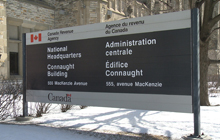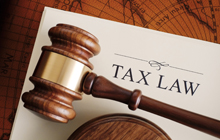The Tax Court Of Canada tests a new procedure – The Preliminary Ruling Docket

2020 initiative driven by increased objections, case backlog
TORONTO – With the rise of the internet and the plethora of information available to anyone with a smartphone, there has been a marked increase in taxpayers who choose to self-represent when they appeal their assessments to the Tax Court of Canada. Additionally, an increased budget to audit and compliance programs at the Canada Revenue Agency ("CRA") has led to more aggressive reassessment action against businesses and individuals. These and other issues, such as the more rigid approach to the objection process being taken by CRA have led to more and more taxpayers needing to take their cases in front of a judge for satisfaction. Thousands of appeals are made to the Tax Court each year, some self-represented, others with representation by Canadian tax lawyers.
This has led to increased backlog at the Court, and hearing dates, when assigned, are often times set down for a year and a half to two years into the future. The Tax Court, which has a history of innovation in this area, has proposed some new changes to its procedures that it began testing on January 1, 2020 in order to try and alleviate some of this strain.
Practice Note 23: The Preliminary Ruling Docket
On December 12, 2019, the Tax Court of Canada published Practice Note 23 "Preliminary Ruling Docket Procedure." The Tax Court of Canada Act and the Tax Court of Canada Rules reserve control for the Court's own procedures with the Court itself, and thus many small and large changes to the manner in which Tax Court appeals are conducted are often made through the release of such notes to the public and the profession.
For example, one of the earlier methods by which the Tax Court attempted to clear up some of the backlog on its docket was through the relaxing of the rules of settlement, and by imposing strict cost consequences on both the taxpayer and the Crown if reasonable settlement offers are not accepted and one party does as well or better should an appeal go all the way to hearing. While most of these changes have now been prescribed through the Rules, the Tax Court continues to tweak the details; this is usually done on a test basis though the issuance of a Practice Note before it is formally prescribed as that process takes much longer.
Practice Note 23 and the Preliminary Ruling Docket, when analyzed are clearly an extension of the principles behind the previous overhauling of the settlement rules. Practice Note 23 officially took effect on January 1, 2020 for a limited test run in the Toronto and Vancouver areas served by the Tax Court. In a nutshell, the use of the Preliminary Ruling Docket allows the parties to obtain a non-binding preliminary ruling to test if their case has the requisite evidence and legal tenability to be successful, but it also applies cost consequences similar to the settlement rules as a further incentive to force the parties to "move along" and come to a resolution.
Preliminary Ruling Docket: The Basics
The goal of the Preliminary Ruling Docket is to allow the parties to obtain a non-binding opinion of a judge of the Tax Court in advance of entering the discovery process in order to save both time and costs. The rules of evidence are relaxed, and the parties are able to present their case to a judge and receive a decision within 60 days on the merits of their position.
The use of this procedure is limited to certain scenarios, and in order to qualify the following conditions precedent must be met:
- A trial of the appeal is expected to last more than two days;
- The Preliminary Ruling hearing can be completed within no more than two days;
- Both parties are represented by counsel;
- The appeal is brought under the general procedure;
- The appeal only involves questions of fact, or mixed fact and law; and
- The amounts in dispute are subject to minimum and maximum thresholds in order to be considered. The amount for income tax must be at least $25,000 and no more than $300,000, while the amount for GST/HST appeals must be at least $50,000 and no more than $300,000.
As long as these conditions are met, and the parties submit a joint application with reasons why they feel the appeal should be subject to this procedure they will qualify.
Preliminary Ruling: Effects
The effect of having undertaken a Preliminary Ruling hearing is that a judge of the Tax Court will issue a written preliminary ruling within sixty days, to which the parties have a thirty day period to accept or reject the judge's decision. If the parties accept, they are to jointly file a consent to judgment with the Court on a without costs basis in accordance with the ruling as laid out by the judge.
If the parties both reject the ruling, then the litigation returns to the regular rules and the parties are expected to file a joint application for a timetable to complete the remaining steps in the discovery process.
Where things get interesting is that if only one party chooses to reject the preliminary ruling, then the ruling itself is then deemed to be a settlement offer given by the party that accepted for the purposes of determining costs once the case has been tried and judgment has been issued. As such, the process is aimed at the same goal as settlement discussions, saving the court's time and preserving increasingly scarce judicial resources.
Tax Tips: Always Keep Any Affected Years in Dispute
It will be interesting to see how Practice Note 23 affects the outcome of costs decisions in future cases. On its face, the Preliminary Ruling regime has the potential to create additional incentive for the parties to reach a settlement before the discoveries begin, but this remains to be seen.
Taxpayers that have an ongoing dispute with the CRA that will end up in Tax Court should always be represented by experienced Canadian tax counsel, but in order to take advantage of this new procedure this will be a requirement. And rightfully so, for there are some pitfalls, such as the fact that evidence given at a preliminary hearing can be used to impeach witnesses at trial, in the same manner as examinations for discovery.
David J Rotfleisch, CPA, JD, is the founding tax lawyer of Rotfleisch & Samulovitch P.C., a Toronto-based boutique tax law firm. With over 30 years of experience as both a lawyer and chartered professional accountant, he has helped start-up businesses, resident and non-resident business owners and corporations with their tax planning, with will and estate planning, voluntary disclosures and tax dispute resolution including tax litigation. Visit www.Taxpage.com and email David at david@taxpage.com.









(0) Comments